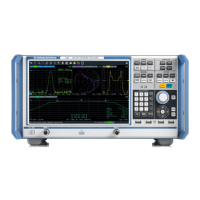GUI Reference
R&S
®
ZNB/ZNBT
406User Manual 1173.9163.02 ─ 53
Optional Columns
Each selected (checked) option adds a column to the segment list and the point list.
●
"Name" allows you to assign a name to each segment. A segment name is a string
that is allowed to contain letters, numbers and special characters.
●
"Power (Pb)" allows you to define the internal source power (channel base power)
for each individual sweep segment. See "Power" on page 386.
If checked, you have the possibility to define port-specific power levels by selecting
the related ports in the "Advanced Ports (Pb) Power" table. Unselected ports are
driven with the segment-specific power.
●
"Meas Bandwidth" defines the IF filter bandwidth for each individual sweep seg-
ment. See "Bandwidth" on page 391.
●
"Frequency Sweep Mode" defines whether the "Stepped" or "Swept" mode is used
for the sweep segment (see Chapter 5.1.4.4, "Stepped vs. Swept Mode",
on page 89).
Swept mode is only supported for linear frequency sweeps. And even for linear fre-
quency sweeps there are measurement setups that are incompatible with swept
mode: an information popup displays the corresponding error code and description
(see [SENSe<Ch>:]SWEep:GENeration:ANALog:CONDition?).
●
"Selectivity" defines the selectivity of the IF filter used for each sweep segment.
See "Selectivity" on page 391.
●
"LO < > RF" allows you to define segment-specific "Image Suppr." settings; see
"Image Suppr." on page 535.
●
"Segment Bits" enables the definition of a segment-dependent 4-bit binary value to
control four independent output signals at the USER PORT connector (lines 16, 17,
18, 19; see Chapter 11.3.1.1, "USER PORT", on page 1381). The output signals
are 3.3 V TTL signals which can be used to differentiate between up to 16 inde-
pendent analyzer states.
For an application example, refer to the detailed remote control description
(OUTPut<Ch>:UPORt:SEGMent<Seg>[:VALue]).
Setting the segment bits does not change the analyzer state.
Sweep Softtool

